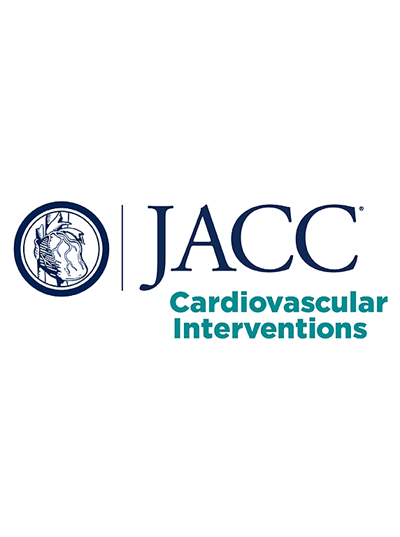美国可膨胀主动脉瓣内置换术的中期结果
IF 11.4
1区 医学
Q1 CARDIAC & CARDIOVASCULAR SYSTEMS
引用次数: 0
摘要
背景:主动脉瓣内置换术被批准用于手术风险高或禁忌的手术瓣膜退行性患者,主要基于小系列和短期随访。目的:本研究的目的是分析采用现代球囊可膨胀瓣膜(bev)治疗AViV的中期预后。方法胸外科学会(STS)/美国心脏病学会TVT(经导管瓣膜治疗)登记的bev患者(2015年6月至2023年12月)与本地经导管主动脉瓣置换术(TAVR)患者倾向匹配。主要分析包括5岁时的死亡和中风。根据STS评分、BEV亚型、支架手术与无支架手术指标瓣膜类型进行比较。结果共匹配了14474例AViV患者和385556例TAVR患者(13638对)。平均年龄为74岁,平均STS预测死亡风险为6.1%。急诊心脏手术(0.2%)和生物瓣膜骨折(22%)不常见。死亡率(43.1% vs 55.2%; P < 0.001)、卒中(10.5% vs 11.8%; P < 0.001)及其综合指数在5年时,与TAVR相比,AViV低于TAVR,在每个STS指标中都有相似的结果。SAPIEN 3 Ultra RESILIA装置在所有尺寸(20mm, 19.4 mm Hg vs 23.8 mm Hg; 23mm, 15.1 mm Hg vs 19.2 mm Hg; 26mm, 12.1 mm Hg vs 15.1 mm Hg; 29mm, 8.6 mm Hg vs 12.1 mm Hg)下均显示出较低的放电回波梯度。无支架手术瓣膜组与支架手术瓣膜组5年死亡或卒中发生率无差异(42.9% vs 46.0%; P = 0.12)。结论:在中期随访中,这项大规模的真实分析证实了在所有手术风险水平下,AViV与TAVR相比的安全性和持久性。可以考虑扩大AViV的适应症。本文章由计算机程序翻译,如有差异,请以英文原文为准。
Mid-Term Outcomes of Balloon-Expandable Aortic Valve-in-Valve Replacement in the United States
Background
Aortic valve-in-valve (AViV) replacement for is approved for patients with degenerated surgical valves at high or prohibitive surgical risk, mostly on the basis of small series with short-term follow-up.
Objectives
The aim of this study was to analyze the outcomes of AViV therapy using contemporary balloon-expandable valves (BEVs) in a large series with mid-term outcomes.
Methods
BEV AViV patients (June 2015 to December 2023) in the Society for Thoracic Surgeons (STS)/American College of Cardiology TVT (Transcatheter Valve Therapy) Registry were propensity matched to native transcatheter aortic valve replacement (TAVR) patients. Primary analysis included death and stroke at 5 years. Comparisons were also made on the basis of STS score, BEV subtype, and stented vs stentless index surgical valve type.
Results
In total, 14,474 AViV patients were matched to 385,556 TAVR patients (13,638 pairs). The mean age was 74 years, and the mean STS Predicted Risk of Mortality was 6.1%. Emergency cardiac surgery (0.2%) and bioprosthetic valve fracture (22%) were infrequent. Death (43.1% vs 55.2%; P < 0.001), stroke (10.5% vs 11.8%; P < 0.001), and their composite were lower for AViV compared with TAVR at 5 years with similar findings at each STS tertile. The SAPIEN 3 Ultra RESILIA device demonstrated lower discharge echo gradients for all sizes (20 mm, 19.4 mm Hg vs 23.8 mm Hg; 23 mm, 15.1 mm Hg vs 19.2 mm Hg; 26 mm, 12.1 mm Hg vs 15.1 mm Hg; and 29 mm, 8.6 mm Hg vs 12.1 mm Hg). There was no difference in death or stroke at 5 years for stentless vs stented surgical valves (42.9% vs 46.0%; P = 0.12).
Conclusions
This large, real-world analysis confirms the safety and durability of AViV compared with TAVR at all surgical risk levels at mid-term follow-up. Consideration may be given to broadening the indication for AViV.
求助全文
通过发布文献求助,成功后即可免费获取论文全文。
去求助
来源期刊

JACC. Cardiovascular interventions
CARDIAC & CARDIOVASCULAR SYSTEMS-
CiteScore
11.60
自引率
8.80%
发文量
756
审稿时长
4-8 weeks
期刊介绍:
JACC: Cardiovascular Interventions is a specialist journal launched by the Journal of the American College of Cardiology (JACC). It covers the entire field of interventional cardiovascular medicine, including cardiac, peripheral, and cerebrovascular interventions. The journal publishes studies that will impact the practice of interventional cardiovascular medicine, including clinical trials, experimental studies, and in-depth discussions by respected experts. To enhance visual understanding, the journal is published both in print and electronically, utilizing the latest technologies.
 求助内容:
求助内容: 应助结果提醒方式:
应助结果提醒方式:


